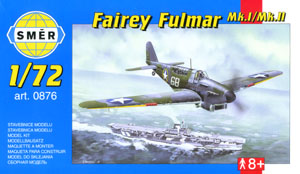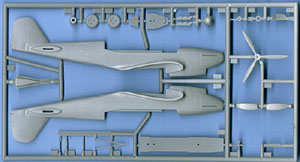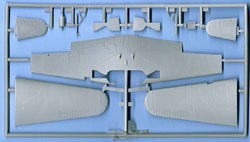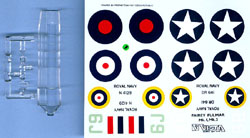Smer's 1/72 Fairey
Fulmar Mk. I/II |  |  The Kit The Kit
The name Vista is probably not well known to many modelers out there, but they released quite a few kits in Eastern Europe. Many of these are now being reboxed by Smer and are reaching a broader audience. The Fairey Fulmar is one of these kits. If you were thinking that this was just a warmed over Frog kit, guess again. Recessed panel lines are present throughout, and the canopy is injection-molded and quite thin and clear. Detailing is fairly basic, with a simplistic interior and rudimentary landing gear, but everything is crisply molded with no flash present. Looking at the interior, the basics are there, with a full floor, pilot's bulkhead, instrument panel, rudder pedals, control stick and seats. There's no sidewall detailing and the pieces included are simplistic, but the basics are there to build off of. Some added strip styrene to the fuselage sides and some radio boxes will add a lot to the appearance here. For those who don't want to go to all that trouble, some seat belts will be a nice touch without a lot of work.  The fuselage has a separate insert for the tailhook, with the tailhook itself provided as a separate piece. The chin scoops for the Fulmar Mk. II are also separate, as are the exhaust stubs. The propeller assembly is an interesting collection of four pieces, with the propeller shaft fitting into a large insert that then fits into the fuselage. A ring fits onto the end of the propeller shaft, allowing the propeller to spin. The final piece for the propeller assembly is the spinner, making it very easy to paint the spinner a different color. The fuselage has a separate insert for the tailhook, with the tailhook itself provided as a separate piece. The chin scoops for the Fulmar Mk. II are also separate, as are the exhaust stubs. The propeller assembly is an interesting collection of four pieces, with the propeller shaft fitting into a large insert that then fits into the fuselage. A ring fits onto the end of the propeller shaft, allowing the propeller to spin. The final piece for the propeller assembly is the spinner, making it very easy to paint the spinner a different color.
The wings are split into separate upper right and left sections, with a one-piece lower section. The landing light is provided as a clear piece, although the wing pieces do not blank this off. Some plastic card and a clear lens will add a lot here with little extra work. While you have the plastic card out, you might want to run some along the edges of the wheelwells to blank those off too. There is some detail present in the upper wing for the wheel well, but some extra work here wouldn't hurt. The landing gear doors will need to be cut apart for displaying the gear down. The landing gear itself is fairly basic but does the job, with the mainwheels separate. The tailwheel assembly is also separate.  The decals offer a pair of choices for Fulmars. One is a Fulmar Mk. I of No. 803 Squadron FAA flying from the HMS Formidable in 1941. The second is a Fulmar Mk. II of No. 809 Squadron FAA flying from HMS Victorious in 1942. Both planes are finished in slate gray and dark sea gray over sky. The Mk. I from 803 Squadron is coded 6J, with the codes in sky, and carries what appears to be a unit badge on the nose. The serial is N4129 for this plane, while that for the Mk. II Fulmar is DR641. The Mk. II Fulmar is one that took part in Operation Torch and is finished in American markings, with the 6B fuselage code in white. The decals are printed by Propagteam and look to be in good register. The only complaint I have is that there is a slight edge around the yellow where the undercoat of white didn't reach the edge. On a dark plane like the Fulmar this might be a problem. The decals offer a pair of choices for Fulmars. One is a Fulmar Mk. I of No. 803 Squadron FAA flying from the HMS Formidable in 1941. The second is a Fulmar Mk. II of No. 809 Squadron FAA flying from HMS Victorious in 1942. Both planes are finished in slate gray and dark sea gray over sky. The Mk. I from 803 Squadron is coded 6J, with the codes in sky, and carries what appears to be a unit badge on the nose. The serial is N4129 for this plane, while that for the Mk. II Fulmar is DR641. The Mk. II Fulmar is one that took part in Operation Torch and is finished in American markings, with the 6B fuselage code in white. The decals are printed by Propagteam and look to be in good register. The only complaint I have is that there is a slight edge around the yellow where the undercoat of white didn't reach the edge. On a dark plane like the Fulmar this might be a problem.
Conclusion The Fairey Fulmar isn't a very popular aircraft so the chances that we'll see a bunch of kits from different manufacturers is slight. Luckily the Smer kit appears to be a nice example of this British Naval fighter. While some of the detail is basic, with a bit of extra plastic it can really look sharp. | 

 



|
